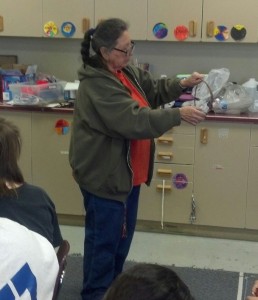 Due to the generous support of Humanities Montana, I was able to secure the wonderful speaking and presentation skills of Louise Ogemahgeshig Fischer for cultural studies at Intermountain school four consecutive Thursdays in May. Louise is well known in the Native American community and brings a wealth of experience in not only sharing her culture, but how to do so in a way that connects with children. Both the staff and the children have really enjoyed the talks and activities that Louise has shared with us.
Due to the generous support of Humanities Montana, I was able to secure the wonderful speaking and presentation skills of Louise Ogemahgeshig Fischer for cultural studies at Intermountain school four consecutive Thursdays in May. Louise is well known in the Native American community and brings a wealth of experience in not only sharing her culture, but how to do so in a way that connects with children. Both the staff and the children have really enjoyed the talks and activities that Louise has shared with us.
The key to successful spiritual and cultural formation within the children at Intermountain is to look for aspects of religious and cultural life that affirm the values and foundational elements of our relational developmental treatment model. Through activities that introduce our children to a breadth of cultural and religious expression, they can see what unites all people despite our differences in beliefs and practices.
For example, I was able to express to the children that the Native American practice of smudging (bathing in smoke) is not unlike the Christian practice of confession. Each seeks to reflect on the need to cleanse the heart and mind and to refocus on the spiritual reality that imperfect as we are, we are invited to join in community with our Creator. Further, as children had the opportunity to make dream catchers and weave braids in their beading craft, Louise talked about the three parts of the braid symbolizing self, family/community, and the spiritual world. How much better off would we all be if we kept in mind these strands of our being?
By attending to self, the “world within,” we can learn what Jesus meant when he said, “love your neighbor as you love yourself.” Love of self, and self-acceptance in the light of God’s grace, provides a reservoir from which to extend love and grace to others. By considering the role of family and community, we might recognize that, created in the image of a self-revealing God, we are all called to live in community and harmony with one another. If we contemplate our connectedness to community, increasingly possible on a world-wide scale due to advances in technology, then we can understand why Jesus would command us to “do good to your enemy and pray for those who persecute you.” Finally, the awareness that—try as we might—we are irrevocably spiritual beings connected to a spiritual reality outside our immediate senses, might cause us to have a greater understanding of what it means to “live by faith and not by sight.”
It has been a joy to work with Louise Ogemahgeshig Fischer, and I hope that this month will prove to be just the beginning of a wonderful partnership in attending to the cultural enrichment of our children on campus. By the way… if you are wondering what Louise’s middle name means, the basic meaning can be explained as “the light above all lights” (my apologies in advance for not capturing the “exact” meaning). Isn’t that a wonderful reflection on the nature of our God?

 Click here to subscribe to our RSS feed with your favorite email client and be alerted to new articles.
Click here to subscribe to our RSS feed with your favorite email client and be alerted to new articles.